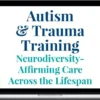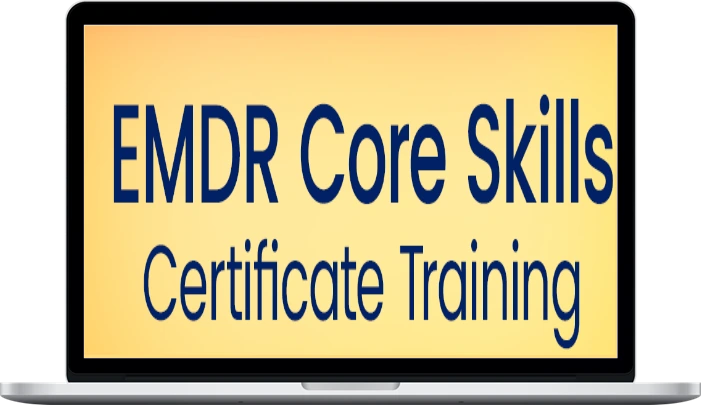Stacy Ruse – EMDR Core Skills : A Self-Paced Online Program for Treating PTSD, Complex Trauma and More
$399.95 $240.00
»Delivery: Within 7 days
Description
Stacy Ruse – EMDR Core Skills: A Self-Paced Online Program for Treating PTSD, Complex Trauma and More
5 Reasons This is the Right Training for You to Learn EMDR
- Expert-Led: Learn from leading EMDR trainer Stacy Ruse, whose trainings on EMDR and trauma have been taken by over 3,000 students.
- Learn at Your Pace: This online programme allows you to watch videos on-demand, pause and review key concepts, and learn at your speed.
- Ongoing Support: Access monthly live Q&A sessions to dive deeper, get advice, and clarify any areas of confusion — ensuring you walk away with full confidence.
- Real-World Application: See EMDR in action in detailed video demonstrations, giving you a front-row seat to how the work unfolds in real therapeutic settings.
- Value You Can’t Beat: Get over 36 hours of in-depth, expert-led EMDR instruction, live support sessions, and access to training materials — all for a fraction of what you’d pay for other trainings.
What you’ll learn in EMDR Core Skills
Module 1 : Setting the Stage for Trauma Healing: Understanding the Brain, Body, Nervous System and More
We’ll kick things off by exploring how the brain keeps us safe, how trauma shows up in our bodies, and how it impacts things like the autonomic nervous system and stress responses. We’ll simplify concepts like Polyvagal Theory, neuroception, and the window of tolerance, plus talk about early developmental trauma, dissociation, and the important role the social engagement system plays in healing. We’ll end this section by introducing EMDR therapy and take a look at the research that supports its effectiveness.
Module 1 Outline
- Core types and levels of trauma
- Traumatic experiences
- Single event trauma
- Complex trauma
- Ruptures in relationships
- Neurobiology of trauma and symptomology
- Adverse Childhood Experiences
- ACEs study
- C-PTSD symptoms
- Avoidance behaviours
- Flashbacks
- Somatic experiences of trauma
- Stress response and the brain
- Polyvagal Theory
- Autonomic nervous system
- Neuroception
- Shut down response
- Early developmental trauma
- Dissociation
- Social engagement system
- Sympathetic responses
- Window of tolerance
- EMDR and EMDR Research
Module 2: Getting Started with EMDR Therapy: Core Concepts and Techniques
In this module, you’ll learn the foundations of EMDR therapy, including the Adaptive Information Processing (AIP) model and the 3-pronged approach to treatment. We’ll cover how to identify and address dissociation, the role of Bilateral Stimulation (BLS) in processing trauma, and psychoeducation strategies to help clients understand the process. Additionally, you’ll learn key red flags to watch for during sessions, equipping you with the tools to begin using EMDR in your practice.
Module 2 Outline
- Appropriateness for EMDR
- Handling crisis
- Stabilisation
- Suitability for processing
- What to look for
- Readiness factors
- Starting EMDR safely
- Screening for dissociation
- Signs of dissociative disorders
- The goal of EMDR therapy
- Bilateral Stimulation (BLS)
- Psychoeducation
- Forms of BLS and BLS set-up
- Red flags
- Adaptive Information Processing and the AIP model
- 3-pronged approach
Module 3: Mastering the 8-Phase EMDR Protocol: A Comprehensive Guide to Trauma Processing and Integration
Time to dive into the good stuff! In this section, you’ll learn how to apply all eight phases of EMDR therapy—from gathering your client’s history and creating a treatment plan to closure and integration. You’ll get the tools to assess your clients, prepare them for trauma work, select and process memory targets, and help them build stronger, positive beliefs. We’ll also cover practical techniques to manage emotions and body sensations, and keep everything on track during therapy. And don’t worry—there’s an in-depth demonstration video to guide you through each step, making it easy to follow along.
Module 3 Outline
- Phase 1 History Taking and Treatment Planning
- Gathering information considering past, present, and future
- Readiness and potential targets
- Major life events and early attachment
- Developing a treatment plan
- Phase 2 Resourcing and Preparation
- Resourcing and state change exercises
- Coping skills, mindfulness, and distress tolerance
- Set-up EMDR therapy mechanics
- BLS mechanics
- Prepare a stop signal
- Metaphors
- Phase 3 Target Selection and Assessment
- Stimulate and access the primary aspects of the memory
- Taking a baseline measurement
- Floatbacks and scripts
- Core belief themes
- Negative cognitions
- Self-blame
- Forming positive cognitions
- Phase 5 Installation of Positive Cognitions
- Strengthening the adaptive positive cognition
- Enhancing the Validity of Cognition
- Linking to the target
- Selecting positive cognitions
- Phase 6 Body Scan
- Check for residual body sensations
- Process negative sensations
- When is phase 6 complete?
- Enforcing positive sensations with BLS
- Phase 7 Closure
- Goals of closure
- Instructions for closing all sessions
- Closing a completed target
- Closing an incomplete target
- Phase 8 Reevaluation and Integration Goals
Module 4 : EMDR Issues, Additions, and Adaptations
In this module, we’ll help you tackle some of the common challenges that can come up in EMDR therapy, like stuck processing, blocking, and looping. We’ll also dive into the emotional complexities your clients might face—powerlessness, anger, guilt, and shame—and show you how to approach them with care. You’ll learn specialised techniques like Attachment-Focused and Somatic-Focused EMDR, as well as strategies for working with kids and teens. Plus, we’ll cover important topics like legal and ethical considerations, cultural competency, telehealth practices, and contraindications, ensuring you’re equipped to offer safe, effective treatment every step of the way.
Module 4 Outline
- What to do when processing gets stuck?
- Blocking and looping
- Exploring powerlessness, anger, guilt, and shame
- Interweaves
- Attachment-Focused EMDR
- Somatic Focused EMDR
Comprehensive EMDR Review and Pulling it All Together
The course ends with a thorough review of everything you’ve learned, making sure you feel confident with the material. PLUS you’ll cover how to work with diverse populations, tackle trauma and co-occurring disorders like addiction using EMDR, and to master techniques like interweaves and distancing. You’ll also learn how to manage overarousal and use resourcing strategies to support your clients. Includes exercises for you to actively engage with, reinforce what you’ve learned, and make it all stick.
More courses from the same author: Stacy Ruse
Delivery Policy
When will I receive my course?
You will receive a link to download your course immediately or within 1 to 21 days. It depends on the product you buy, so please read the short description of the product carefully before making a purchase.
How is my course delivered?
We share courses through Google Drive, so once your order is complete, you'll receive an invitation to view the course in your email.
To avoid any delay in delivery, please provide a Google mail and enter your email address correctly in the Checkout Page.
In case you submit a wrong email address, please contact us to resend the course to the correct email.
How do I check status of my order?
Please log in to HealthcareCourse account then go to Order Page. You will find all your orders includes number, date, status and total price.
If the status is Processing: Your course is being uploaded. Please be patient and wait for us to complete your order. If your order has multiple courses and one of them has not been updated with the download link, the status of the order is also Processing.
If the status is Completed: Your course is ready for immediate download. Click "VIEW" to view details and download the course.
Where can I find my course?
Once your order is complete, a link to download the course will automatically be sent to your email.
You can also get the download link by logging into your HealthcareCourse account then going to Downloads Page.
Related products
Total sold: 1
Total sold: 2
Total sold: 1










